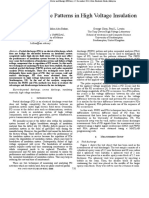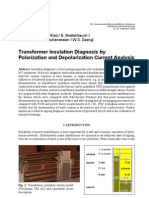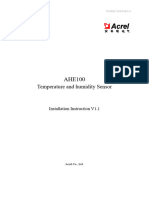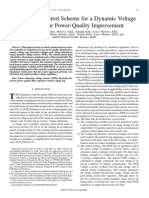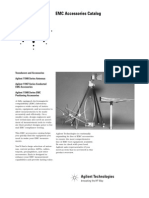Study On Different Techniques of Partial Discharge (PD) Detection in Power Transformers Winding: Simulation Between Paper and EPOXY Resin Using UHF Method
Study On Different Techniques of Partial Discharge (PD) Detection in Power Transformers Winding: Simulation Between Paper and EPOXY Resin Using UHF Method
Uploaded by
ashwiniCopyright:
Available Formats
Study On Different Techniques of Partial Discharge (PD) Detection in Power Transformers Winding: Simulation Between Paper and EPOXY Resin Using UHF Method
Study On Different Techniques of Partial Discharge (PD) Detection in Power Transformers Winding: Simulation Between Paper and EPOXY Resin Using UHF Method
Uploaded by
ashwiniOriginal Description:
Original Title
Copyright
Available Formats
Share this document
Did you find this document useful?
Is this content inappropriate?
Copyright:
Available Formats
Study On Different Techniques of Partial Discharge (PD) Detection in Power Transformers Winding: Simulation Between Paper and EPOXY Resin Using UHF Method
Study On Different Techniques of Partial Discharge (PD) Detection in Power Transformers Winding: Simulation Between Paper and EPOXY Resin Using UHF Method
Uploaded by
ashwiniCopyright:
Available Formats
International Journal of Conceptions on Electrical and Electronics Engineering
Vol. 2, Issue. 1, April 2014; ISSN: 2345 - 9603
Study on different techniques of partial discharge
(PD) detection in power transformers winding:
Simulation between paper and EPOXY resin using
UHF method
Irfan Ali Soomro and Md Nor Ramdon
Department of Electrical Power Engineering (JEK)
Universiti Tun Hussein Onn Malaysia (UTHM)
Johor, Malaysia
eng.irfansoomro@gmail.com and ramdon@uthm.edu.my
Abstract Increasing load on power transformers causes the
stress on power transformers. Due to continuously stress on
power transformers weakens the insulation of winding and
producing arcing called partial discharge (PD). Partial
discharges seriously affect the reliability of power transformers
and lead to destroy transformer. Insulating materials play a
major role in longevity of power transformer. The objective of
this paper is to contrast the different techniques used for
detection and localization of PD at the initial stage in power
transformer winding and to investigate which is the best
insulating materials (paper and epoxy resins) to be used to
prolong the power transformers life expectancy. From
literature, it is found that information regarding detection of PD
in power transformer is not enough to perform necessary action
because the location of PD is still unknown. So localization of PD
is necessary to recommend corrective actions. In order to
overcome this problem, different techniques such as electrical
method, acoustic method, UHF detection method and optical
methods are used to locate and detect the PD. UHF detection
method has a many advantages compared to other PD detection
methods such as immunity against background noise and other
unwanted signals that can affect the measurement, reduce the
design complexity, reduce the design cost and provides the
accurate and precise location of PD source. From the simulation,
it is found that the paper is most recommended to be used as
insulating material in power transformers compare to epoxy
resins due to papers electrical properties.
Keywords- Acoustic method, Electrical method, optical method,
Partial Discharge (PD), UHF detection
I. INTRODUCTION
Partial discharges (PD) are one of the main causes of
deterioration of insulating material in power transformer
windings. Many researches already had been done to find PD
mechanism, the PD detection techniques, the relationship
between PD and the damage they cause to insulating materials
and insulating system, the location of PD sources and the
problems related to avoid external interference [1]. The
reliability of power transformers mainly depends on the
condition of insulation. Therefore any indication of terrible
failure must be detected at early stage. it is widely accepted
that the presence of PD may start and lead to failure of power
transformer. Even though there is no direct relationship
between occurrences of PD in power transformer failure, it is
widely accepted that the presence of PD may start and lead to
failure of power transformer. If the PD pulse allowed to
growing overtime, it can cause the insulation to deteriorate
which may lead to complete breakdown of the power
transformer insulation [2].PD is an electrical discharge or
sparks that bridge small fraction of insulating between two
conducting electrodes. PD can occur when electric field
strength go beyond the breakdown strength of insulation and
can lead to flashover [3]. PD is most common phenomena
which occur in high voltage equipment especially power
transformer and power cables. Several causes of occurrence of
PDs are ageing in the insulation and electrical overstressing on
equipment or presence of defects (voids, cracks) presented
during manufacturing [4]. Power transformer reliability can be
seriously affected by partial discharge (PD) [5].
Various methods such as electrical, acoustic, UHF
detection and optical methods have been proposed for detection
and localization of PD in power transformer winding. Nonelectric PD location methods include the acoustic techniques
which uses acoustic emission from the discharge and time
difference travel to acoustic sensor. Electrical PD detection
method measures apparent charge quantity using conventional
PD measuring circuitry and instruments with an effective
frequency bandwidth of less than 500KHz. Ultra High
frequency (UHF) PD detection utilizes the frequency
components of a discharge signal in range of 300MHz-3GHz
for detecting discharge in power transformers. Since electrical
methods of PD detection are more sensitive, electrical location
techniques are preferable for PD online monitoring [6].
57 | 7 1
Partial discharges seriously affect the reliability of power
transformers and lead to destroy transformer. The objective of
this paper is to contrast the different techniques used for
detection and location of partial discharge at the time of
creation in power transformer winding.
II. PD DETECTION METHODS
There are several difficulties are faced to detect the fault
and location of fault in power transformer winding. So to
overcome these difficulties several techniques are used for
detection and localization of partial discharge in power
transformer winding as shown in figure.
Figure1. Partial Discharge Detection Methods
A.
Electrical Detection Methods
Electromagnetic measurement of PD consists of coupling
devices and data acquisition unit. The most suitable frequency
bands for application regarding each power system are from
30-300MHz and 300MHz-3GHz [7]. The pulse shape, its
relative phase location within the AC cycle of the power
transformer, and the signal intensity all lead to information
about the type of PD fault and the severity of the insulation
damage.
Electrical measurements are grouped into two categories,
direct probing and RF emission testing. The direct probing
method requires that capacitive couplers be connected to the
phase terminals of the transformer. The second group, RF
emission testing is conducted by using antennas in the area of
the transformer. These processing methods make online
electrical PD detection very attractive because it makes realtime monitoring of power transformer. But electrical detection
has limitations. The primary limitation of electrical testing is its
susceptibility to noise. The power transformers environment
contain high levels of electrical noise, both narrowband and
broadband. In some cases, it is extremely difficult to
distinguish between noise and a PD because of the short PD
pulse width. This problem leads to false detection in online
electrical PD systems. The transformer can be taken offline and
connected to an external power source for testing in order to
eliminate some of the noise but taking the power transformer
offline can cost hundreds of thousands of dollars a day in lost
revenue for the power company [8].
B.
Acoustic Detection Methods
The acoustic method is very attractive alternative for online partial discharge detection in power transformers. The
transformer tank is grounded; therefore the sensors can be
placed in a safe way, over any point of any wall of transformer
tank in order to detect the acoustic emission of partial
discharges [5].
Acoustic signals from a PD source are immune from
electromagnetic noise. An acoustic signal from mechanical
vibration of PD can be detected by piezoelectric transducers,
fiber optic acoustic sensors, accelerometers, condenser
microphones and sound-resonance sensors usual using
frequency band as between 10 kHz and 300 kHz. Acoustic
emission detection has been successfully used in order to
localize the PD source inside of the test object due to the fact
that acoustic signal is strongly dependent upon the geometry of
the test object. This method is very efficient for localizing PD
source because of its immunity against electromagnetic noise
[7].
The primary problem with acoustic detection is the
complex nature of the acoustic wave propagation. Because
power transformers are not homogeneous devices, the waves
do not travel in perfect spherical wave fronts because the
source of PD is so small, it can be seen as an acoustic point
source. Due to the nature of wave propagation, point sources
lead to spherical wave fronts. Another difficulty with acoustic
detection is the required sensitivity. Classically, due to the
many attenuation mechanisms, received acoustic signals have
very low intensity and so sensors must be very responsive to
small changes in signal amplitude in order to detect a PD [8].
C.
UHF Detection Methods
Ultra High Frequency (UHF) detection method is one of the
online PD detection in power transformer. Thus UHF PD
detection has an advantage of strong anti-interference ability
over traditional detection approaches [10]. Firstly, ultra-high
frequency (UHF) partial discharge detection was mostly
focused on gas insulation substation (GIS). In recent two
decades, research fields about UHF partial discharge detection
have mainly included propagation characteristic of UHF
electromagnetic wave in GIS [8], sensor design and
optimization, UHF amplifier, default models in GIS and pattern
classification, signal processing and features extraction. UHF
partial discharge detection applied in power transformer is been
was rampantly investigated for the past few years [9].
However, as a novel partial discharge detection method, the
ultra-high frequency partial discharge detection also can be
used in non-gas insulation electrical power apparatus such as
transformer, cables and so on.
D.
Optical Detection Methods
Optical emission from PD can be detected by optical
sensors. Unlike electrical signals from PD, optical signals
largely depend on different factors such as insulation material,
temperature, PD intensity and pressure. There are roughly two
kind of optical PD detection techniques as a result of different
kind of ionization, excitation and recombination processes
during the discharge; direct detection of optical PD signal and
detect of change of an optical beam. Detection of optical signal
58 | P a g e
includes surface detection and the detection inside of the test
object such as GIS and transformer. The optical sensors
transferring signal to the outside at photomultiplier, also can be
placed inside the test object which is efficient for a light-tight
GIS impulse voltage test. This impulse voltage test is not
suitable for an electrical PD detection system. Another method
called opto-acoustic measurement catches sonic or ultrasonic
range acoustic emission caused by PD which results in
deformation of the optical fiber. One recent paper [9] describes
optical PD detection on Over Head Transmission Line (OHTL)
using fiber optic sensors with Light Emitting Diodes (LEDs),
resulting in meaningful PD detection capability. The main
advantages of this method are the immunity from
electromagnetic interferences and high sensitivity compared to
conventional electrical techniques [7].
TABLE II.
COMPARISON OF UHF DETECTION AND OPTICAL PD
DETECTION METHODS
UHF Detection
Advantages
Immunity against
electrical noise
Very efficient for
localization of PD
Identification of PD
source
Relative expensive cost
Complex design
UHF sensors
RF sensors
Antennas(Hilbert,
monopole, loop antenna
etc)
Optical
Immunity
against
electrical noise
Easy to measure
Provide critical
information
Go/No Go
decision
No information
about
magnitude of
PD
Disadvantages
III. COMPARISON OF THE PD DETECTION METHODS
Element which are used in the comparison between
Electrical and Acoustic method are advantages, disadvantages,
possible sensors and main application area. Clear data is
shown in Table I.
TABLE I.
COMPARISON OF ELECTRICAL AND ACOUSTIC PD
DETECTION METHODS
Electrical
Application for all kinds
of high voltage equipment
Intensity source, type,
location of PD is
assessable
The most suitable for
continuous online PD
monitoring
High electromagnetic
interference
Advantages
Disadvantages
Possible
sensors
Main
application
area
Possible
sensors
Acoustic
High sensitivity
Immunity
against
electrical noise
Very efficient
for localization
of PD
Low signal
intensity
Not good for
continuous PD
measurement
Piezo-electric
transducers
Inductive
Condenser
microphones
All High Voltage
Equipment
Transformers
GIS
Capacitive
Element which are used in the comparison between UHF
Detection and Optical methods are advantages, disadvantages,
possible sensors and main application area. Clear data is
shown in Table II.
IV.
All High Voltage
Equipment
Optical fiber
UV detector
Photomultiplier
tube
Transformer
GIS
Cables
a simplified model of a power transformer using Computer
Simulation Tool Microwave Studio (CST MWS) software.
Winding
Relative expensive cost
Main
application
area
CST MWS SIMULATION
Study on the effects of paper and epoxy resin materials in
power transformer winding is shown in Figure 2 by simulating
Antenna (Probe)
Figure 2: Connection of antennas in power transformer winding
The descriptions of the figures, the simulated high voltage
winding consists of 50 helical circular turns, each turn has
3mm thickness and there are 5mm gap between the helical
circular turns on the paper and epoxy resin insulating material.
Two short dipole antennas with Gaussian excitation current
signal in the UHF frequency range (0.3 to 3GHz) is been used
to create the PD source. At the surface of the power
transformer tank, probes to monitor electric fields in various
positions were considered in the analysis [13]. Coordinates of
short dipole antenna (port) and probes in power transformer
winding are shown in Table III. Probe position is shown in
Table IV.
59 | P a g e
TABLE III.
COMPARISON OF UHF DETECTION AND OPTICAL PD
DETECTION METHODS
Potential PD site for dipole
antenna (1)
Along X-axis
Along Y-axis
Along Z-axis
TABLE IV.
From (mm)
To(mm)
57
80
-70
60
82
-75
COMPARISON OF UHF DETECTION AND OPTICAL PD
DETECTION METHODS
Coordinates of the Antenna Positions
Probe Index
x, y, z Probe coordinates (mm)
Probe#1
(0, -150, -110)
V. RESULT
According to the above table, a short dipole antenna with
UHF Gaussian excitation is placed in a supposed PD location.
Then, the electromagnetic (EM) wave propagation from the
paper insulation of winding is simulated and recorded by the
probe position, which is placed at the position of the detecting
antenna. Typical location of antenna is listed in Table III and
Table IV. The electric field signals recorded by the probe for
supposed PD location at (x,y,z) coordinates (0,-150,-110) mm.
A.
Paper insulation
Figure 3 shows the result of the probe and dipole antenna
having coordinates which is shown in Table III and Table IV.
Coordinates are plotted in the graph, whereby x-axis indicates
the time and y-axis indicates the electric field. Figure 3 shows
that partial discharge will start about 2ns and will reach up to
maximum at 5.597ns.
Figure 3: CST MWS simulated result in paper
B.
Epoxy Resins
Figure 4 shows the result of two probe and dipole antenna
having coordinates which is shown in Table III and Table IV.
Coordinates are plotted in the graph whereby x-axis indicates
the time and y-axis indicates the electric field. Figure 4 shows
that partial discharge will start about 2ns and will reach up to
maximum at 2.97ns.
VI. DISCUSSION AND CONCLUSION
From the literature review, it is found that acoustic
detection methods have advantages over electrical detection
methods. The primary advantage of acoustic detection over
electrical method is that position information is readily
Figure 4: CST MWS simulated result in epoxy resins
available from acoustic system using multiple sensors.
Another advantage of acoustic over electrical is its immunity
to electromagnetic interference (EMI). This EMI makes
acoustic detection ideal for online PD detection. Experimental
investigation reveals that UHF detection method has
advantages over acoustic detection methods. The acoustic PD
detection sensitivity is seriously affected when the discharges
are hidden within insulation obstacles in this regard UHF. PD
detection sensitivity fairs better and is seen unaffected by
obstacles, even small level of discharge could be recorded
with good sensitivity. The optical detection method has
advantage that it has immunity to electromagnetic interference
and also easy measurement of PD but this method has a
disadvantage that no magnitude of PD signal and relatively
expensive.
From the above discussion, it is found that UHF PD
detection methods and acoustic detection methods have many
advantages than other methods, major inherent advantages of
UHF PD detection method are better noise immunity and good
sensitivity to low level discharges hidden inside the insulation
and also have also identifying the source of PD. The electrical
method has a primary limitation of electrical testing which
makes its weakness to noise. The power transformer
environment contains high levels of electrical noise. In some
cases, it is extremely difficult to distinguish between noise and
a PD because of the short PD pulse width. This problem leads
to false detection in online electrical PD systems. The
transformer can be taken offline and connected to an external
power source for testing and repairing in order to eliminate
some of the noise, from discussion it is found that acoustic and
UHF PD detection methods detect and localizing PD with
accurate position.
Based on the result obtain during simulation analysis, it is
found that the paper insulating material have more
sustainability and strength compare to epoxy resins. This
result is obtained because the time taken by the PD to reach up
to maximum at 5.597ns in paper vice versa in epoxy resin the
PD takes approximately 2.97ns to reach up to maximum level.
Therefore paper is usually recommended to be used as an
insulating material in power transformer. On the other hand,
paper has less conductivity compare to epoxy resin due to its
chemical properties. Paper is meant to be solid and epoxy
resin is found in gel form. Other than that, paper is easily
available in the market at a lower cost.
60 | P a g e
Based on the simulation result, it is found that the
electromagnetic waves can easily penetrate the insulating
materials in the power transformer. Paper insulations are
commonly used in the power transformer because the dielectric
strength only weakens after longer period of time compare to
the epoxy resin. Strength of the paper will only weaken after a
longer period of time which makes it to be the best insulating
material. Paper has a very high withstand stress which can be
used to reduce the maintenance cost of power transformer.
REFERENCES
[1]
[2]
[3]
[4]
[5]
[6]
[7]
[8]
[9]
[10]
M. Danikas, N. Gao, and M. Aro, Partial discharge recognition using
neural networks: a review, Electrical Engineering, vol. 85, pp. 8793,
2003.
H. H. Sinaga, Detection, Identification And Localization Of Partial
Discharges In Power Transformers Using UHF Techniques".The
University of New South Wales Australia. Doctor Of Philosophy, 2012.
M. Yaacob, M. AlSaedi, and N. A. Al Gizi, Partial discharge signal
detection using ultra high frequency method in high voltage power
equipments: a review, ijser.org, vol. 4, no. 1, pp. 16, 2013.
A. Rahman, L. Hao, P. Rapisarda, and P. Lewin, Partial discharge
simulation for a high voltage transformer winding using a model based
on geometrical dimensions, p. 106, 2012.
J. Ramrez-Nio and a Pascacio, Acoustic measuring of partial
discharge in power transformers, Measurement Science and
Technology, vol. 20, no. 11, p. 115108, Nov. 2009.
[11]
[12]
[13]
61 | P a g e
Z. Wang, A measurements-based discharge location algorithm for plain
disc winding power transformers, Dielectrics and Electrical, no.
December 2003, pp. 416422, 2005.
C. S. In, On-line PD (partial discharge) Monitoring of power system
components, Aalto University. Masters Degree, 2011.
A. Lazarevich, Partial discharge detection and localization in high
voltage transformers using an optical acoustic sensor, Virginia
Polytechnic Institute and State University. Masters Degree, 2003.
Oliveira, S.C.; Fontana, E., Optical Detection of Partial Discharges on
Insulator Strings of High-Voltage Transmission Lines,
Instrumentation and Measurement, IEEE Transactions on Volume: 58,
Issue: 7, Page(s): 23282334, 2009.
J. Li, T. Jiang, C. Wang, and C. Cheng, Optimization of UHF hilbert
antenna for partial discharge detection of transformers, Antennas and
Propagation vol. 60, no. 5, pp. 25362540, 2012.
X. Gaofeng, A calculational method of transient electric field excited by
partial discharge in gas insulated substation using dyadic Green
function, Proceedings. International Conference on Power System
Technology, vol. 3, pp. 14381441, 2002.
L. Yang and M. D. Judd, Recognising multiple partial discharge sources
in power transformers by wavelet analysis of UHF signals, IEE
Proceeding-Science, Measurement and Technology, vol. 150, no. 3, pp.
119, 2003.
Gockenbach, E. and Miralikhani, K. (2013). A Novel Method for Ultra
HighFrequency
Partial
Discharge
Using
the
Particle
Swarm.IEEEElectrical Insulation Magazine, 26-39, 2013.
You might also like
- Ruralstar Site Tower Construction SOP V3.0No ratings yetRuralstar Site Tower Construction SOP V3.048 pages
- WP - Virtual Magnetic Field Assessment - v2No ratings yetWP - Virtual Magnetic Field Assessment - v210 pages
- A2-205 - 2018 Localization of Partial Discharge Sources in Transformers by Analysis of Signals in Time - and Frequency-Domain PDFNo ratings yetA2-205 - 2018 Localization of Partial Discharge Sources in Transformers by Analysis of Signals in Time - and Frequency-Domain PDF18 pages
- Partial Discharge Patterns in High Voltage InsulationNo ratings yetPartial Discharge Patterns in High Voltage Insulation7 pages
- Characterization of Phase Resolved Partial Discharge Waveforms From Instrument Transformer Using Statistical Signal Processing TechniqueNo ratings yetCharacterization of Phase Resolved Partial Discharge Waveforms From Instrument Transformer Using Statistical Signal Processing Technique6 pages
- M6 Dielectric Spectroscopy: University of Potsdam, Institute of Physics Advanced Lab Experiments May 31, 2001No ratings yetM6 Dielectric Spectroscopy: University of Potsdam, Institute of Physics Advanced Lab Experiments May 31, 200121 pages
- Interpretation of Dielectric Spectroscopy Results in Time and Frequency Domains For Power CablesNo ratings yetInterpretation of Dielectric Spectroscopy Results in Time and Frequency Domains For Power Cables7 pages
- UHF PD: Non-Conventional Sensors For Measurements On GIS of Different DesignsNo ratings yetUHF PD: Non-Conventional Sensors For Measurements On GIS of Different Designs6 pages
- Digital Testing of High Voltage Circuit Breaker-2No ratings yetDigital Testing of High Voltage Circuit Breaker-223 pages
- Transformer Insulation Diagnosis by Polarization and Depolarization Current AnalysisNo ratings yetTransformer Insulation Diagnosis by Polarization and Depolarization Current Analysis8 pages
- Using Dielectric Frequency Response To Assess Insulation in BushingsNo ratings yetUsing Dielectric Frequency Response To Assess Insulation in Bushings20 pages
- Doble Lemke Power Transformer Advanced PD Monitoring UHF 2009No ratings yetDoble Lemke Power Transformer Advanced PD Monitoring UHF 200921 pages
- Non-Stationary Signal Analysis Software - WT9362 & WT9364: Brüel &No ratings yetNon-Stationary Signal Analysis Software - WT9362 & WT9364: Brüel &4 pages
- 569-AHE100 Temperature and Humidity Sensor Installation InstructionV1.1-20220124No ratings yet569-AHE100 Temperature and Humidity Sensor Installation InstructionV1.1-202201246 pages
- Transmission line structures with Fiber Reinforced Polymer (FRP) compositeNo ratings yetTransmission line structures with Fiber Reinforced Polymer (FRP) composite241 pages
- Detection of Partial Discharge Acoustic Emission INo ratings yetDetection of Partial Discharge Acoustic Emission I7 pages
- Condition Based Ranking For Reliability Centered Maintenance of Circuit BreakerNo ratings yetCondition Based Ranking For Reliability Centered Maintenance of Circuit Breaker6 pages
- Breake Rmonitoring With Numerical RelayNo ratings yetBreake Rmonitoring With Numerical Relay22 pages
- Microcontroller Based Substation Monitoring and Control System With GSM Modem100% (1)Microcontroller Based Substation Monitoring and Control System With GSM Modem9 pages
- RTU300 Hardware Manual: - RTU300 - RTU302 RTU SeriesNo ratings yetRTU300 Hardware Manual: - RTU300 - RTU302 RTU Series25 pages
- Data Mining of Substation Relay Data: Mythili Chaganti Badrul H. ChowdhuryNo ratings yetData Mining of Substation Relay Data: Mythili Chaganti Badrul H. Chowdhury7 pages
- Filters and Transfer Functions: Y (Z) y (N) X (Z) X (N) H (Z)0% (1)Filters and Transfer Functions: Y (Z) y (N) X (Z) X (N) H (Z)39 pages
- Omicron - Synchronous Multi-Channel PD Measurements and The Benefits For PD AnalysesNo ratings yetOmicron - Synchronous Multi-Channel PD Measurements and The Benefits For PD Analyses8 pages
- Breaker Monitoring With Numeric Relays: What Are The Difficulties?No ratings yetBreaker Monitoring With Numeric Relays: What Are The Difficulties?22 pages
- Classification of Partial Discharge DeteNo ratings yetClassification of Partial Discharge Dete7 pages
- Artificial Intelligence SF6 Circuit Breaker Health AssessmentNo ratings yetArtificial Intelligence SF6 Circuit Breaker Health Assessment9 pages
- Partial Discharge in Gas Insulated Substations GIS Effects Mitigation AnalysisNo ratings yetPartial Discharge in Gas Insulated Substations GIS Effects Mitigation Analysis6 pages
- IDC - HV Conf - Perth 2015 - Condition Monitoring of High Voltage Switchgear - KHNo ratings yetIDC - HV Conf - Perth 2015 - Condition Monitoring of High Voltage Switchgear - KH58 pages
- CB Monitor: On Line Circuit Breaker Monitoring SystemNo ratings yetCB Monitor: On Line Circuit Breaker Monitoring System4 pages
- Modeling of Photovoltaic Systems Using MATLAB: Simplified Green CodesFrom EverandModeling of Photovoltaic Systems Using MATLAB: Simplified Green CodesNo ratings yet
- Partial Discharge Localization Techniques - A Review of Recent ProgressNo ratings yetPartial Discharge Localization Techniques - A Review of Recent Progress31 pages
- Microstrip Patch Antenna Based UHF Sensor For Detection of Partial Discharge in High Voltage Electrical EquipmentsNo ratings yetMicrostrip Patch Antenna Based UHF Sensor For Detection of Partial Discharge in High Voltage Electrical Equipments6 pages
- Bess Unit Scheduling Strategy The Lifetime of BESS Is Limited by A Finite Number of Charge - Discharge Cycles and FrequentNo ratings yetBess Unit Scheduling Strategy The Lifetime of BESS Is Limited by A Finite Number of Charge - Discharge Cycles and Frequent2 pages
- TABLE 1. Transition in Charging Rank of BESU During Charging Time IntervalNo ratings yetTABLE 1. Transition in Charging Rank of BESU During Charging Time Interval2 pages
- Proposed WF and Bess Dispatch Strategy: A. Stochastic Programming Model FormulationNo ratings yetProposed WF and Bess Dispatch Strategy: A. Stochastic Programming Model Formulation2 pages
- Problem Definition and Solution ApproachNo ratings yetProblem Definition and Solution Approach1 page
- Qn. Set A Key Qn. Set A Key Qn. Set A KeyNo ratings yetQn. Set A Key Qn. Set A Key Qn. Set A Key3 pages
- Telangana State Power Generation Corporation Limited: ND RDNo ratings yetTelangana State Power Generation Corporation Limited: ND RD4 pages
- Computation of Maximum Loading Points Via The Factored Load FlowNo ratings yetComputation of Maximum Loading Points Via The Factored Load Flow7 pages
- MAY 2015 Number 3 Itpseg (ISSN 0885-8950) : Guest EditorialNo ratings yetMAY 2015 Number 3 Itpseg (ISSN 0885-8950) : Guest Editorial2 pages
- What Will 5G Be?: IEEE Journal On Selected Areas in Communications May 2014No ratings yetWhat Will 5G Be?: IEEE Journal On Selected Areas in Communications May 201418 pages
- Civil Service - Electrical Engineering Main Paper I & II - 1992 - 2007No ratings yetCivil Service - Electrical Engineering Main Paper I & II - 1992 - 2007147 pages
- Slotted Ground Microstrip Antenna With FSS Reflector For High-Gain Horizontal PolarisationNo ratings yetSlotted Ground Microstrip Antenna With FSS Reflector For High-Gain Horizontal Polarisation2 pages
- Rolling Wireless S.A R.L. Rw520gl 2ax2urw520gl 2ax2urw520gl Rw520glNo ratings yetRolling Wireless S.A R.L. Rw520gl 2ax2urw520gl 2ax2urw520gl Rw520gl3 pages
- Multibeam Transmitarrays For 5G Antenna Systems: Michele Beccaria, Andrea Massaccesi, Paola Pirinoli, Linh Ho ManhNo ratings yetMultibeam Transmitarrays For 5G Antenna Systems: Michele Beccaria, Andrea Massaccesi, Paola Pirinoli, Linh Ho Manh5 pages
- 2450APBC Canopy 2.4 GHZ Access Point AdvantageNo ratings yet2450APBC Canopy 2.4 GHZ Access Point Advantage1 page
- References Zvi Paltiel: NUMALOG (1985-1991)No ratings yetReferences Zvi Paltiel: NUMALOG (1985-1991)5 pages
- 3.1 How To Protect The Bare-Hand Live-Line Workers Under The Low Frequency Electromagnetic FPNo ratings yet3.1 How To Protect The Bare-Hand Live-Line Workers Under The Low Frequency Electromagnetic FP8 pages
- EN Switched Beam Smart Antenna For WirelessNo ratings yetEN Switched Beam Smart Antenna For Wireless8 pages
- W-Interference Processing Guide: Huawei Technologies Co., LTDNo ratings yetW-Interference Processing Guide: Huawei Technologies Co., LTD49 pages
- ECE 5233 Satellite Communications: Prepared By: Dr. Ivica KostanicNo ratings yetECE 5233 Satellite Communications: Prepared By: Dr. Ivica Kostanic11 pages
- Analysis of Communication Tower With Different HeiNo ratings yetAnalysis of Communication Tower With Different Hei20 pages
- Fourtubingduplexerusingband-Pass and RejectNo ratings yetFourtubingduplexerusingband-Pass and Reject4 pages
- A2-205 - 2018 Localization of Partial Discharge Sources in Transformers by Analysis of Signals in Time - and Frequency-Domain PDFA2-205 - 2018 Localization of Partial Discharge Sources in Transformers by Analysis of Signals in Time - and Frequency-Domain PDF
- Partial Discharge Patterns in High Voltage InsulationPartial Discharge Patterns in High Voltage Insulation
- Characterization of Phase Resolved Partial Discharge Waveforms From Instrument Transformer Using Statistical Signal Processing TechniqueCharacterization of Phase Resolved Partial Discharge Waveforms From Instrument Transformer Using Statistical Signal Processing Technique
- M6 Dielectric Spectroscopy: University of Potsdam, Institute of Physics Advanced Lab Experiments May 31, 2001M6 Dielectric Spectroscopy: University of Potsdam, Institute of Physics Advanced Lab Experiments May 31, 2001
- Interpretation of Dielectric Spectroscopy Results in Time and Frequency Domains For Power CablesInterpretation of Dielectric Spectroscopy Results in Time and Frequency Domains For Power Cables
- UHF PD: Non-Conventional Sensors For Measurements On GIS of Different DesignsUHF PD: Non-Conventional Sensors For Measurements On GIS of Different Designs
- Transformer Insulation Diagnosis by Polarization and Depolarization Current AnalysisTransformer Insulation Diagnosis by Polarization and Depolarization Current Analysis
- Using Dielectric Frequency Response To Assess Insulation in BushingsUsing Dielectric Frequency Response To Assess Insulation in Bushings
- Doble Lemke Power Transformer Advanced PD Monitoring UHF 2009Doble Lemke Power Transformer Advanced PD Monitoring UHF 2009
- Non-Stationary Signal Analysis Software - WT9362 & WT9364: Brüel &Non-Stationary Signal Analysis Software - WT9362 & WT9364: Brüel &
- 569-AHE100 Temperature and Humidity Sensor Installation InstructionV1.1-20220124569-AHE100 Temperature and Humidity Sensor Installation InstructionV1.1-20220124
- Transmission line structures with Fiber Reinforced Polymer (FRP) compositeTransmission line structures with Fiber Reinforced Polymer (FRP) composite
- Detection of Partial Discharge Acoustic Emission IDetection of Partial Discharge Acoustic Emission I
- Condition Based Ranking For Reliability Centered Maintenance of Circuit BreakerCondition Based Ranking For Reliability Centered Maintenance of Circuit Breaker
- Microcontroller Based Substation Monitoring and Control System With GSM ModemMicrocontroller Based Substation Monitoring and Control System With GSM Modem
- RTU300 Hardware Manual: - RTU300 - RTU302 RTU SeriesRTU300 Hardware Manual: - RTU300 - RTU302 RTU Series
- Data Mining of Substation Relay Data: Mythili Chaganti Badrul H. ChowdhuryData Mining of Substation Relay Data: Mythili Chaganti Badrul H. Chowdhury
- Filters and Transfer Functions: Y (Z) y (N) X (Z) X (N) H (Z)Filters and Transfer Functions: Y (Z) y (N) X (Z) X (N) H (Z)
- Omicron - Synchronous Multi-Channel PD Measurements and The Benefits For PD AnalysesOmicron - Synchronous Multi-Channel PD Measurements and The Benefits For PD Analyses
- Breaker Monitoring With Numeric Relays: What Are The Difficulties?Breaker Monitoring With Numeric Relays: What Are The Difficulties?
- Artificial Intelligence SF6 Circuit Breaker Health AssessmentArtificial Intelligence SF6 Circuit Breaker Health Assessment
- Partial Discharge in Gas Insulated Substations GIS Effects Mitigation AnalysisPartial Discharge in Gas Insulated Substations GIS Effects Mitigation Analysis
- IDC - HV Conf - Perth 2015 - Condition Monitoring of High Voltage Switchgear - KHIDC - HV Conf - Perth 2015 - Condition Monitoring of High Voltage Switchgear - KH
- CB Monitor: On Line Circuit Breaker Monitoring SystemCB Monitor: On Line Circuit Breaker Monitoring System
- Modeling of Photovoltaic Systems Using MATLAB: Simplified Green CodesFrom EverandModeling of Photovoltaic Systems Using MATLAB: Simplified Green Codes
- Power System Wide-area Stability Analysis and ControlFrom EverandPower System Wide-area Stability Analysis and Control
- Partial Discharge Localization Techniques - A Review of Recent ProgressPartial Discharge Localization Techniques - A Review of Recent Progress
- Microstrip Patch Antenna Based UHF Sensor For Detection of Partial Discharge in High Voltage Electrical EquipmentsMicrostrip Patch Antenna Based UHF Sensor For Detection of Partial Discharge in High Voltage Electrical Equipments
- Bess Unit Scheduling Strategy The Lifetime of BESS Is Limited by A Finite Number of Charge - Discharge Cycles and FrequentBess Unit Scheduling Strategy The Lifetime of BESS Is Limited by A Finite Number of Charge - Discharge Cycles and Frequent
- TABLE 1. Transition in Charging Rank of BESU During Charging Time IntervalTABLE 1. Transition in Charging Rank of BESU During Charging Time Interval
- Proposed WF and Bess Dispatch Strategy: A. Stochastic Programming Model FormulationProposed WF and Bess Dispatch Strategy: A. Stochastic Programming Model Formulation
- Telangana State Power Generation Corporation Limited: ND RDTelangana State Power Generation Corporation Limited: ND RD
- Computation of Maximum Loading Points Via The Factored Load FlowComputation of Maximum Loading Points Via The Factored Load Flow
- MAY 2015 Number 3 Itpseg (ISSN 0885-8950) : Guest EditorialMAY 2015 Number 3 Itpseg (ISSN 0885-8950) : Guest Editorial
- What Will 5G Be?: IEEE Journal On Selected Areas in Communications May 2014What Will 5G Be?: IEEE Journal On Selected Areas in Communications May 2014
- Civil Service - Electrical Engineering Main Paper I & II - 1992 - 2007Civil Service - Electrical Engineering Main Paper I & II - 1992 - 2007
- Slotted Ground Microstrip Antenna With FSS Reflector For High-Gain Horizontal PolarisationSlotted Ground Microstrip Antenna With FSS Reflector For High-Gain Horizontal Polarisation
- Rolling Wireless S.A R.L. Rw520gl 2ax2urw520gl 2ax2urw520gl Rw520glRolling Wireless S.A R.L. Rw520gl 2ax2urw520gl 2ax2urw520gl Rw520gl
- Multibeam Transmitarrays For 5G Antenna Systems: Michele Beccaria, Andrea Massaccesi, Paola Pirinoli, Linh Ho ManhMultibeam Transmitarrays For 5G Antenna Systems: Michele Beccaria, Andrea Massaccesi, Paola Pirinoli, Linh Ho Manh
- 3.1 How To Protect The Bare-Hand Live-Line Workers Under The Low Frequency Electromagnetic FP3.1 How To Protect The Bare-Hand Live-Line Workers Under The Low Frequency Electromagnetic FP
- W-Interference Processing Guide: Huawei Technologies Co., LTDW-Interference Processing Guide: Huawei Technologies Co., LTD
- ECE 5233 Satellite Communications: Prepared By: Dr. Ivica KostanicECE 5233 Satellite Communications: Prepared By: Dr. Ivica Kostanic
- Analysis of Communication Tower With Different HeiAnalysis of Communication Tower With Different Hei





